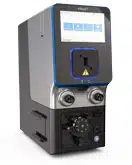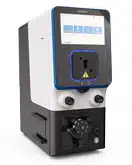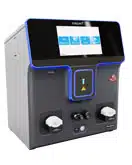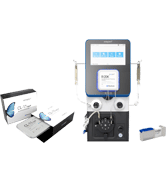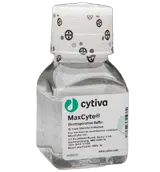The State of CRISPR and Gene Editing Presentation
Translating CRISPR-based Therapies to the Clinic with GMP-compliant, Scalable Electroporation
Virtual breakout session
June 5, 2024
Jim Brady, Senior Vice President of Technical Applications at MaxCyte, presents on how electroporation is an effective tool in engineering scalable cell therapies.
In this enlightening breakout session from The State of CRISPR and Gene Editing summit hosted by Genetic Engineering and Biotechnology News, James Brady, PhD, presents Translating CRISPR-based Therapies to the Clinic with GMP-compliant, Scalable Electroporation.
MaxCyte’s electroporation platform supports cell therapy developers from concept to commercialization. Our Flow Electroporation platform has been used in a wide array of applications and cell types, including CRISPR gene editing, and was developed specifically for use in the clinic.
Key topics covered in this session
- CRISPR Gene Editing: Understand the power of CRISPR technology in precisely modifying genes for therapeutic purposes.
- Clinical Case Studies: Explore real-world examples where MaxCyte’s technology played a pivotal role in advancing cellular therapies.
- Key Advantages: Discover how MaxCyte’s proprietary Flow Electroporation technology enables efficient and scalable delivery of CRISPR components into cells. Learn about the scalability, standardization, and clinical relevance of MaxCyte’s electroporation approach.
Whether you’re a researcher, clinician, or therapy developer, this session provides valuable insights into the future of CRISPR therapies. Let’s dive in!
Watch the The State of CRISPR and Gene Editing breakout session

Case studies presented
Multiplex CRISPR editing for cancer immunotherapy: During this phase 1 clinical trial, researchers focused on engineering patients’ T cells using CRISPR gene editing to enhance the potency of an autologous anticancer T-cell therapy. MaxCyte’s electroporation platform played a crucial role by effectively delivering CRISPR components into patient-derived T cells to edit three loci – TRAC, TRBC and PDCD1 – followed by viral delivery of a tumor-targeting T-cell receptor. The corrected cells were successfully infused into patients with safe and effective results, which demonstrates multiplex human genome engineering is safe and feasible using CRISPR-Cas9.
Non-viral manufacture of a CAR T-cell therapy for B-cell non-Hodgkin lymphoma using CRISPR knock-in: In this case study, researchers simultaneously knocked out the PD-1 checkpoint inhibitor via CRISPR while introducing a CAR gene into the same locus via homology-dependent recombination. These CAR T-cells were infused into patients with the results of significant tumor regression and improved survival rates.
Autologous cell therapy for sickle cell disease and beta-thalassemia: The BCL11A locus was knocked out using CRISPR to induce adult expression of fetal hemoglobin. MaxCyte’s electroporation platform played a crucial role by efficiently delivering CRISPR components into patient-derived hematopoietic stem and progenitor cells (HSPCs). The corrected HSPCs were successfully transplanted into patients, resulting in improved hemoglobin levels and reduced disease symptoms.
Presenter

Have more questions?
Send your question to one of our cell engineering experts.
Transcript
Kevin Davies:
Hello, everyone. Welcome to the MaxCyte breakout session. I'm Kevin Davies, and our thanks to MaxCyte for generously supporting the state of CRISPR and Gene Editing Virtual Summit. MaxCyte provides the leading electroporation platform supporting cell therapy developers from concept to commercialization. This presentation is entitled "Translating CRISPR-based Therapies to the Clinic with GMP-compliant Scalable Electroporation." And, who better to give the presentation than Jim Brady, who is Senior Vice President of Applications at MaxCyte? Jim has extensive experience leveraging MaxCyte platform in a wide array of applications and cell types, including CRISPR gene editing. He's been part of the team who led MaxCyte to become the first and only transfection platform used in the manufacturing of an approved, non-viral cell engineered therapy. Of course, that was Casgevy, which is also the first CRISPR-Cas9-based approved therapy from Vertex Pharmaceuticals and CRISPR Therapeutics approved last year.
Jim, it's a pleasure to welcome you on to the virtual summit today, and we're really looking forward to your presentation. I'll have a few questions for you at the end, no doubt.
Jim Brady:
Great. Well, thank you very much, Kevin. So as this conference highlights, CRISPR-Cas has revolutionized cell therapy research. However, there's still a significant bottleneck in scaling CRISPR-based engineering to meet the demands of industrial therapeutic manufacturing. So today, I want to talk about MaxCyte's approach to overcoming manufacturing challenges for CRISPR-based therapies as well as for other types of cellular therapies. Quick disclaimer.
Now, MaxCyte was founded 25 years ago to enable non-viral engineering of primary cells for therapeutic applications. Our proprietary flow electroporation technology was developed specifically for use in the clinic. And, our mission from the very beginning has been to enable highly efficient loading of molecules into precious cells from patients, wjile imparting minimal perturbation to cellular viability or phenotype. We offer several different instrument models to support researchers and clinicians at all phases of a therapeutic discovery and translational spectrum. Our technology is employed by academic researchers, large pharma and biotechs as well as by CROs, CDMOs and CMOs for many different applications, including cell therapy, but also for bioproduction and drug discovery.
Now, the Flow Electroporation technology developed by MaxCyte can transfect billions of cells during a single run thanks to a process that employs a gentle and stepwise pool of cell fractions into a specially designed chamber. Process consistency is critical in the clinic. And, with the MaxCyte method of Flow Electroporation all cell fractions from a population are processed identically and are then pulled into one consistent batch at the end of the process. Moreover, the movement of cells through the instrument is fully automated, providing much greater scalability, process standardization, and consistency relative to static, research-grade electroporation. Therefore, the technology's software and interchangeable consumables and GMP-compliant protocols can be easily scaled from thousands to billions of cells as needed. MaxCyte provides preoptimized electroporation parameters for a wide variety of primary cells and cell lines. Therefore, users don't need to conduct lengthy optimization studies to identify suitable electroporation settings, and it's not necessary to change any of their parameters during scale up. And with automation, protocols remain robust across laboratories and users. MaxCyte's electroporation technology is compatible with a wide range of upstream cell isolation and concentration technologies, as well as virtually any type of downstream cell culture system, enabling seamless integration of many different closed, GMP cell therapy workflows.
Now, I'd also like to highlight that we provide extensive technical and scientific support to our customers and end users through a worldwide team of experienced field application scientists and an in-house team of applications and process development scientists. And in addition, our technology is supported by an FDA master file.
Now, I'd like to highlight some of MaxCyte's benefits for developers of autologous cellular therapies. I've already touched on ease of use due to preset protocols, high efficiency, and high cell viability, plus process consistency and product potency, are evidenced by data from hundreds of peer-reviewed publications and multiple clinical trials. I'll talk about some of those data later in the presentation. The upper-right graph shows customer-generated data demonstrating consistency of highly efficient CRISPR knockout, in this case of the Cd38 gene in NK cells.
Our processing assemblies are designed to minimize cell loss and the PAs used for Flow Electroporation incorporate bioweldable tubing that enables sterile integration of upstream and downstream technologies. And, the instrument's small footprint, it's ease of use, consistent performance, all facilitate tech transfer across multiple process development labs and manufacturing sites. And then, techs transfers, or tech transfer rather, is further facilitated by MaxCyte's extensive technical and regulatory support services.
Now, here's a list of many different diseases that have been targeted with MaxCyte-engineered cellular therapies in clinical trials. And, this slide also highlights the various gene-engineering strategies that have been enabled by MaxCyte's technologies. In the lower right, I've called Casgevy, which is the first commercially approved CRISPR-engineered stem cell therapy for treating sickle cell disease and beta thalassemia.
This chart shows that both autologous and allogeneic therapies based on MaxCyte engineered cells are advancing through clinical trials, and it highlights the variety of cell types that are being engineered by our customers and partners. And again, you can see Casgevy at the center of the chart.
Now for the remainder of my talk, I'd like to briefly present three case studies based on peer-reviewed publications. These papers all contain clinical data from patients who are treated with CRISPR-engineered cells that were manufactured using MaxCyte electroporation.
The initial case study centers on published data from the first in-human clinical trial for an engineered T-cell cancer immunotherapy involving multiplex CRISPR knockout of three different loci followed by viral delivery of a tumor-targeting T-cell receptor. The MaxCyte Expert GT instrument was used to deliver CRISPR RNPs into autologous patient T cells in order to knock out genes encoding the endogenous T-cell receptor alpha and beta chains, plus the PCD1 gene, which encodes the PD1 immune checkpoint inhibitor. Now, here's the clinical-scale manufacturing workflow. So two days after leukapheresis and elutriation, the MaxCyte instrument was used to electroporate T cells with CRISPR RNPs targeting the three loci I just mentioned. The cells were activated two days later, and then after one more day, the cells were transduced of lentivirus encoding a T-cell receptor targeting the NY-ESO-1 tumor antigen. Following ten days of expansion, the engineered cells were harvested and cryopreserved prior to infusion. So, on the left is a graphic depiction of the cellular engineering strategy, and on the, on the right we see a graph, which illustrates ex vivo expansion of engineered cells from four different patients.
In a tumor coculture or tumor cell coculture assay, MaxCyte engineered cells that were transduced with the TCR-encoding lentivirus exhibited potent antigen-specific cytotoxicity as well as interferon gamma production. Three patients were infused with the CRISPR-engineered TCR cells. Edited T cells engrafted in all three patients and were stable for at least nine months. And at the bottom, you can see 50% regression of a large abdominal mass in one of the patients, as shown in these computer or computed tomography images. So to summarize the first case study, MaxCyte enabled the first clinical application of multiplex CRISPR-based cellular engineering. The engineered cells exhibited enhanced potency in vitro as well as extended persistence post engraftment. And while some chromosomal translocations were detected, those, those cells decreased in frequency. And overall, the authors noted that multiplex human genome engineering is safe and feasible using CRISPR-Cas9.
The second case study is based on published data from a clinical trial in China involving a novel, autologous cellular therapy for treating B-cell non-Hodgkin lymphoma. Now for this application, the researchers wanted to develop an enhanced type of CAR T-cell by integrating an anti-CD19 CAR sequence into the endogenous PD1 locus. So their strategy was to simultaneously knock out the PD1 checkpoint inhibitor via CRISPR while introducing the CAR gene into the same locus via homology-dependent recombination. So, T cells from patients were cotransfected with the CRISPR RNPs targeting PD1 antilinear double-stranded DNA template encoding CD19 CAR, which was flanked by DNA arms with homology to the PD1 locus. Patients were given a lymphocyte-depleting chemotherapy regimen, followed by one infusion of MaxCyte-engineered T cells. Prior to infusion, the engineered cells had viability of greater than 90%, and in the final infusion products, the average percentages of PD1 indel were about 60% and CAR integration frequency was about 20%. This is data from eight different patients. And, here you can see in vivo persistence and proliferation of the engineered cells post infusion in those same eight patients. By measuring the percentage of CD19-positive cells in the peripheral lymphocytes, the authors determined that the cytotoxic activity of PD1-19bbz cells was observed in patients for months after infusion. The authors also reported that the CAR knock-in cells had a higher CD8 to CD4 ratio and an increased number of memory T cells compared to T cells that were transduced with a lentivirus CAR in the absence of PD1 knockout.
During a median observation period of 12 months, complete remission was achieved in seven of the eight patients. However after complete remission, disease relapse was detected in two patients at six months. Partial remission and relapse was observed in the remaining patient, but in a later follow up, durable responses were found in five of the patients. Mild cytokine release syndrome was observed in some patients, but immune effector cell-associated neurotoxicity syndrome, or ICANS, did not occur. So in summary, in this first in-human study of non-viral, specifically integrated CAR-T products, the authors highlighted that non-viral manufacturing is simplified compared to lentiviral CAR delivery with shortened preparation time, reduced production expenses and increased safety and efficacy of the CAR-T cell products. I should also mention that a follow up study was published last year on clinical data from 21 patients, and that study confirm that PD1-19bbz exhibited promising efficacy, along with a manageable toxicity profile.
So, the third and final case study is based on a 2021 publication from the New England Journal of Medicine describing the first two patients that were treated with Casgevy. This is the first approved CRISPR-engineered stem cell therapy for treating transfusion-dependent beta thalassemia and sickle cell disease. And just to provide some background, transfusion-dependent beta thalassemia and sickle cell disease are the most common monogenic diseases worldwide. Mutations that cause thalassemia result in reduced or absent beta globin synthesis, and it causes an imbalance between alpha and beta globin chains of hemoglobin that, in turn, causes a shortage of functional red blood cells, resulting in reduced oxygen supply to tissues, which can lead to organ damage and potentially death. And in the case of sickle cell disease, sickle hemoglobin is caused by a point mutation in beta globin. Polymerization of deoxygenated sickle hemoglobin causes erythrocyte deformation, hemolysis, anemia, it leads to a painful vaso-occlusive episodes and ultimately can cause irreversible end organ damage and reduced life expectancy. So, there are treatment options for both diseases. In the case of thalassemia or transfusion-dependent thalassemia, the primary treatment options consist of a transfusion, which can lead to iron overload, and that requires iron chelation therapy to prevent iron-related toxicity. Sickle cell disease is typically treated by pain management as well as transfusion and hydroxyurea. Both diseases can be cured by allogenic bone marrow transplantation, but less than 20% of eligible patients have a related HLA-matched antigen donor.
So, the goal of this clinical study was to develop an autologous cellular therapy for treating sickle cell disease and transfusion-dependent thalassemia by using MaxCyte electroporation to deliver CRISPR RNPs to patients hematopoietic stem and progenitor cells in order to knock out the BCL11A locus which encodes a protein that normally represses fetal hemoglobin expression in adults. So just to give a little more background behind this strategy, so in sickle cell disease and transfusion-dependent thalassemia, as I mentioned earlier, are caused by lack of adult hemoglobin due to mutations. It turns out that fetuses produce gamma globin rather than beta globin; normally there's a transition in hemoglobin from the fetal stage to the adult stage, and this transition is regulated predominantly by a protein called BCL11A. This is a transcription factor that represses gamma globin in adults. And, it's been noted that in patients with thalassemia and sickle cell disease that have predatory persistence of fetal hemoglobin, those patients show higher or reduced morbidity and mortality. It's also been noted that neonates and infants with thalassemia or sickle cell disease, they're typically asymptomatic while their fetal hemoglobin levels are high. And then, they become symptomatic during the first year when synthesis of fetal hemoglobin declines. So therefore the strategy, again, was to introduce a CRISPR RNP that targets the BCL11A locus. And then by, knocking out BCL11A, that would up regulate expression of the gamma globin in adult red blood cells. And, this targeting would be done in hematopoietic stem and progenitor cells. And then, those cells will ultimately differentiate into erythrocytes.
So here's a simplified schematic of the clinical manufacturing workflow. Before infusion with the engineered cell product, patients underwent myeloablation with busulfan to reduce or, to actually, deplete mutant hematopoietic stem cells. And here, you can see in the patient with transfusion-dependent thalassemia, after infusion, levels of fetal hemoglobin increased rapidly. And by six months, 99.7% of circulating red blood cells were expressing fetal hemoglobin. And, this patient's fetal hemoglobin levels remained within normal range or their overall hemoglobin levels remain within normal range at 18 months, which in the case of this reported study was the last time point that they included in this study. And for the patient with sickle cell disease, the CTX001 product consisted of two manufacturing lots that were pooled, the allelic editing frequencies were 82.6% and 78.7%, respectively, in those two lots. And, this patient also exhibited rapid expansion of fetal hemoglobin levels post infusion. Ninety-nine percent, or 99.9% of circulating cells expressed fetal hemoglobin at 115, again, the most recent data point in this reporting study.
So in summary, MaxCyte enabled highly efficient gene editing of the BCL11A enhancer in autologous hematopoietic stem and progenitor cells from thalassemia and sickle cell disease patients. The CTX001 treatment in both patients produced early, substantial, and sustained increases in fetal hemoglobin levels during a 12-month period. And finally, I'd like to mention that earlier this month, the New England Journal of Medicine published a study of phase three clinical trial results for 30 sickle cell disease patients who were treated with CTX001, which in the publication was referred to as exa-cel. And, those authors reported that the treatment eliminated vaso-occlusive crises in 97% of patients who had sickle cell disease, and that, freedom from vaso-occlusive events persisted for 12 months or more following a one-time treatment.
So before I conclude, I'd just like to re-emphasize MaxCyte's unwavering commitment to enabling the development and manufacturing of life-changing cellular therapies. We support our partners and, ultimately, patients through best-in-class instrumentation, high-level technical and regulatory support, cGMP compliance, and a corporate culture that reflects 25 years of devotion to advancing non-viral cellular engineering. So at this point, I'd like to thank everyone for listening, and I'd like to thank GEN for organizing this informative conference. So, thank you very much.
Kevin Davies:
Thank you so much, Jim. That was a concise but really interesting and remarkable summary of, as you say, 25 years of innovation and, increasingly now, life, life-changing cell therapies that you've played such an instrumental role in developing. A few questions before we let you go. You've now, as you discussed in those final few slides, seeing your instrumentation and your technology, not just sort of have exciting potential that you've been working towards, but now really, change the lives of literally dozens of patients with sickle cell disease and thalassemia. I wonder if you could somehow summarize what it's meant to you and your colleagues to, to, have kind of crossed that threshold. Not that, you know, we're calling this a cure just yet, but what does it mean to, to, the company to have played such a crucial role in, in building this therapeutic pipeline and building the instrumentation that has enabled this, this, this therapeutic pipeline. This led to the approval last year of Casgevy.
Jim Brady:
Yeah. Know obviously it's hugely rewarding for myself and my colleagues. You know, I, I've, worked in other companies where you can spend years developing a therapie that never makes it to the clinic. So working for MaxCyte where we see our technology involved in so many different clinical workflows and enabling so many different therapies for cancer and sickle cell disease. And, to see there's a real payoff to the work that we do in our lab and that, that work translates into improvements in the lives of patients. And yeah, it's kind of hard to put into words exactly how we feel, but it's clearly very rewarding. And, we feel like we're just on the cusp of many larger and greater advances that are going to take place in the coming years.
Kevin Davies:
When I had the chance to meet you on a visit to MaxCyte earlier this year, you spent a few minutes telling me and, sort of, educating me about the science and the technology of electroporation. And, I wondered if I could just indulge you to spend a minute or two, helping the audience understand. It sounds so naively straightforward, "Oh, we just zapped the cells," and, you know, it all happens like magic. And, I wonder if you can begin to summarize the amount of innovation and research that had to go into figuring out the safest, and yet, most efficient way to allow things like CRISPR to enter cells and do to the great things that it can do.
Jim Brady:
Sure. I mean, electroporation has actually been around for many years. I used it when I was in graduate school, which tells you how long it's been around. And, the basic premise of electroporation really hasn't changed very much. You're exposing a cell to an electric field or a series of electrical pulses, and that creates temporary perturbations to the cellular membrane.
You know, maybe picturing discrete holes in the cell may be overly simplistic, but that's a helpful way to imagine what's going on. And, then molecules are delivered into the cell, and then the membrane repairs itself. But, I think there challenges coming, of course, in terms of translating the research-grade electroporation that many of us are familiar with into the clinic. So, the quality of the electrodes, the composition, the buffer, all has to be GMP compliant. One of the biggest challenges that we faced was figuring out how to scale up electroporation. So there are a lot of electroporators that work with a few million cells or a few thousand cells. But, if you want to process billions of cells at one time, what we figured out is that we have to flow the cells through the electroporation chamber, figuring out how to do that while maintaining consistency without overheating the cells—those are not trivial challenges. So, those are some of the biggest innovations that we introduced. And then, just, introducing people to the fact that you don't need viruses to deliver DNA or to deliver genes to the cells. There are other modalities like RNA-based delivery or transposon-based delivery that are just as effective as viral-based delivery, much safer and much more cost effective. So, it was really, I guess, we had to overcome technical challenges, but then we also had to do some changes to people's mindsets to accept electroporation.
Kevin Davies:
Do you think after 25 years, you're finally, you finally figured out how electroporation works? Or, do you feel there is still room, headroom, for further technical developments and innovation?
Jim Brady:
Yeah, no, that's an interesting question. I mean, electroporation is currently a highly efficient process. We can load most cells with greater than 90% efficiency, but I think there is certainly going to be room, at least for peripheral technologies, to advance. So for example, we're going to see advances in the molecules people are loading into cells. We've already seen tremendous advances in CRISPR-based editing reagents and derivatives of CRISPR prime editors; and the adjacent technologies, the cell-isolation steps that the downstream culture technologies, maybe associated analytics. I think those are all going to play into helping CRISPR-based therapies and electroporation-based therapies become commonplace, and, and maybe ultimately, even a point-of-care type of applications.
Kevin Davies:
Two more questions before I let you go. Are you, can you, and this isn't a business presentation, but what are you seeing in terms of, you know, the outlook over the next 12 months? So, do you see MaxCyte's technology being applied in, in a growing number of clinical trials? I guess the answer to that would be yes. But I wonder if you could put some context into it.
Jim Brady:
Yeah. As I tried to highlight at the beginning of my presentation, there are already many, many clinical trials ongoing with MaxCyte at the heart of the manufacturing process. And, we certainly expect that number to increase. And, you know, T cells have been sort of the workhorse for cellular therapies. But, we're seeing increasing interest in other cell types, like NK cells, macrophages, IPSC-derived therapies are becoming more, more prevalent. So, I think in the coming year or two we're going to see, obviously, increasing use of electroporation in the clinic, but an expansion in terms of the number of cell types and the number of engineering strategies that are being used in conjunction with electroporation.
Kevin Davies:
And, I know that earlier this year you had a chance, to, to meet and actually take on a tour of your facility, Victoria Gray, who was the first patient in the Casgevy examples that you mentioned in that New England Journal of Medicine paper from 2021. And now, of course, the update that you just mentioned. That must have been a really special moment for you and, really, everyone at the company to, to meet her, to hear about her journey and to watch, literally, you know, playing with the, the, the exploration instrument that, that transformed her cells.
Jim Brady:
Yeah, absolutely. It was a real privilege to meet Victoria and to have her in our labs and to hear her story. I mean, she's, she's endured a tremendous amount of suffering and, and experienced things that most of us can never imagine experiencing. And also, I think it took a lot of courage for her to be the first patient to be treated with this, this very experimental type of therapy. And obviously, it's proven to be safe and efficacious. But at that time, she was taking a big leap and then undergoing that treatment. And, to have her in our lives and to have her get to touch the equipment and understand how the process works first hand, it was, it was a quite an exciting day for all of us.
Kevin Davies:
Very good. Well, Jim, let's leave it there. Thank you so much for your presentation today. And to MaxCyte for, for, organizing such a, an interesting contribution to, to the stage of CRISPR and Gene Editing Summit. So that pretty much concludes, this particular breakout session. And in just a couple of minutes, we'll begin the final session here at the State of CRISPR. And Gene editing a conversation with Savannah Coleman and Patrick Shu, the co-founders of the Art Institute.
We look forward to seeing you there. Thanks for watching.
